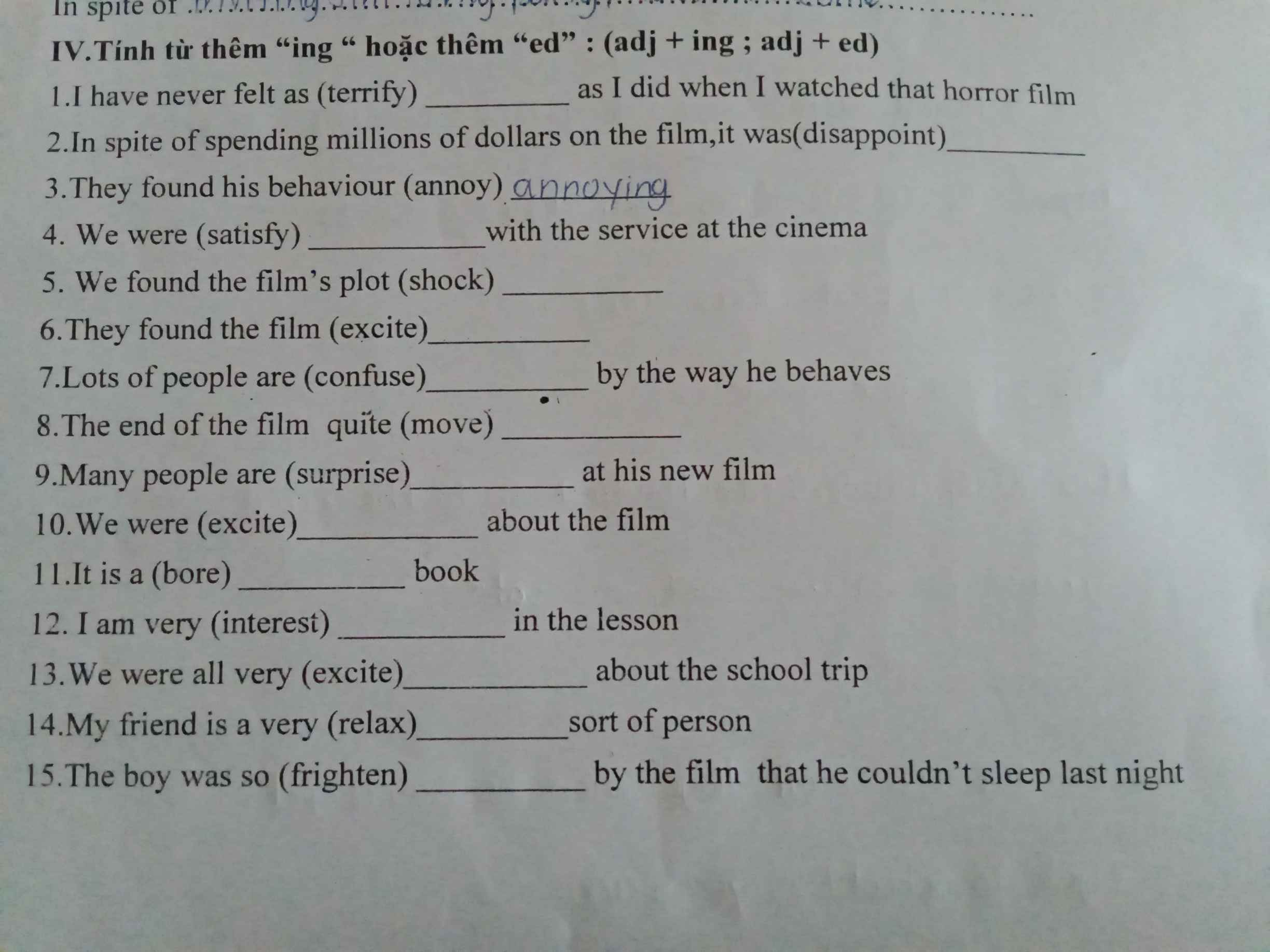Ai giúp mik bài này vs ạ

Những câu hỏi liên quan
Giúp mik vs, nếu ai thấy đc bài này thì hãy giúp mik vs ạ. Mik camon mn
/ 2x - 3 / = 3 - 2x
Các bạn ơi giải giúp mik bài này vs ạ! Đáp án của bài này là S = {x ∈ R / x =< 3/2} mà mik ko biết cách giải ạ! Ai biết giúp mik vs! Thanks nhiều!
\(\left|2x-3\right|=3-2x\)
\(ĐK:x\le\dfrac{3}{2}\)
\(\Leftrightarrow\left[{}\begin{matrix}2x-3=3-2x\\3-2x=3-2x\end{matrix}\right.\)
\(\Leftrightarrow\left[{}\begin{matrix}x=\dfrac{3}{2}\\0=0\left(đúng\right)\end{matrix}\right.\)
Vậy \(S=\left\{x\in R;x=\dfrac{3}{2}\right\}\)
Đúng 1
Bình luận (0)
Mọi người ơi ai bt giải giúp mik bài này vs ạ, mik đg cần gấp lắm
Giúp mik bài này vs ạ mik đang cần gấp
b: Xét ΔABE vuông tại A có AH là đường cao ứng với cạnh huyền BE
nên \(BH\cdot BE=AB^2\left(1\right)\)
Xét ΔABC vuông tại B có BH là đường cao ứng với cạnh huyền AC
nên \(AH\cdot AC=AB^2\left(2\right)\)
Từ (1) và (2) suy ra \(BH\cdot BE=AH\cdot AC\)
Đúng 0
Bình luận (0)

giúp mik bài này vs ạ mik cảm mơn nhiều!
![]()
giúp mik bài này vs ạ ^^
Câu 10
a) \(-\dfrac{4}{3}+x=\dfrac{2}{3}\)
\(x=\dfrac{2}{3}+\dfrac{4}{3}\)
\(x=2\)
b) \(\dfrac{x}{7}=\dfrac{y}{9}=\dfrac{z}{8}\) \(\Rightarrow\dfrac{x}{7}=\dfrac{2y}{18}=\dfrac{3z}{24}\)
và \(x+2y-3z=-8\)
Áp dụng tính chất của dãy tỉ số bằng nhau, ta có:
\(\dfrac{x}{7}=\dfrac{2y}{18}=\dfrac{3z}{24}=\dfrac{x+2y-3z}{7+18-24}=\dfrac{-8}{1}=-8\)
\(\dfrac{x}{7}=-8\Rightarrow x=-8.7=-56\)
\(\dfrac{y}{9}=-8\Rightarrow y=-8.9=-72\)
\(\dfrac{z}{8}=-8\Rightarrow z=-8.8=-64\)
Vậy \(x=-56;y=-72;z=-64\)
c) \(\left(3x-y+5\right)^2+\left|x-\dfrac{2}{3}\right|\le0\)
Do \(\left(3x-y+5\right)^2\ge0;\left|x-\dfrac{2}{3}\right|\ge0\)
\(\Rightarrow\left(3x-y+5\right)^2+\left|x-\dfrac{2}{3}\right|=0\)
\(\Rightarrow\left(3x-y+5\right)^2=0;\left|x-\dfrac{2}{3}\right|=0\)
*) \(\left|x-\dfrac{2}{3}\right|=0\)
\(\Rightarrow x-\dfrac{2}{3}=0\)
\(x=\dfrac{2}{3}\)
*) \(\left(3x-y+5\right)^2=0\)
\(\Rightarrow3x-y+5=0\)
\(3.\dfrac{2}{3}-y+5=0\)
\(2-y+5=0\)
\(-y+7=0\)
\(y=7\)
Vậy \(x=\dfrac{2}{3};y=7\)
Câu 11:
Gọi x (học sinh, y (học sinh), z (học sinh), t (học sinh) lần lượt là số học sinh giỏi, khá, trung bình, yếu của khối 7 theo chỉ tiêu của nhà trường
Do số học sinh giỏi, khá, trung bình, yếu lần lượt tỉ lệ với 9; 14; 11; 3 nên:
\(\dfrac{x}{9}=\dfrac{y}{14}=\dfrac{z}{11}=\dfrac{t}{3}\)
Do số học sinh khá nhiều hơn số học sinh trung bình là 15 học sinh nên:
\(y-z=15\)
Áp dụng tính chất của dãy tỉ số bằng nhau, ta có:
\(\dfrac{x}{9}=\dfrac{y}{14}=\dfrac{z}{11}=\dfrac{t}{3}=\dfrac{y-z}{14-11}=\dfrac{15}{3}=5\)
\(\dfrac{x}{9}=5\Rightarrow x=5.9=45\)
\(\dfrac{y}{14}=5\Rightarrow y=5.14=70\)
\(\dfrac{z}{11}=5\Rightarrow z=5.11=55\)
\(\dfrac{t}{3}=5\Rightarrow t=5.3=15\)
Vậy số học sinh giỏi, khá, trung bình, yếu của khối 7 theo chỉ tiêu của nhà trường lần lượt là: 45 học sinh; 70 học sinh; 55 học sinh; 15 học sinh
Đúng 1
Bình luận (0)
Câu 11:
Áp dụng tính chất của dãy tỉ số bằng nhau, ta được:
\(\dfrac{a}{9}=\dfrac{b}{14}=\dfrac{c}{11}=\dfrac{d}{3}=\dfrac{b-c}{14-11}=5\)
Do đó: a=45; b=70; c=55; d=15
Đúng 0
Bình luận (0)
GIÚP MIK BÀI NÀY VS Ạ!
1: \(\Leftrightarrow3^x\cdot\dfrac{1}{7}\cdot3+3^x\cdot9\cdot\dfrac{1}{2}=\dfrac{23}{14}\cdot3^5\)
=>\(3^x\left(\dfrac{3}{7}+\dfrac{9}{2}\right)=\dfrac{23}{14}\cdot3^5\)
=>\(3^x\cdot\dfrac{69}{14}=\dfrac{23}{14}\cdot3^5\)
=>\(3^{x+1}\cdot\dfrac{23}{14}=\dfrac{23}{14}\cdot3^5\)
=>\(3^{x+1}=3^5\)
=>x+1=5
=>x=4
2: \(\Leftrightarrow4^x\cdot\dfrac{64}{5}+4^x\cdot\dfrac{4}{7}=4^5\cdot\dfrac{117}{35}\)
=>\(4^x\left(\dfrac{64}{5}+\dfrac{4}{7}\right)=4^5\cdot\dfrac{117}{35}\)
=>\(4^{x+1}\cdot\left(\dfrac{16}{5}+\dfrac{1}{7}\right)=4^5\cdot\dfrac{117}{35}\)
=>\(4^{x+1}=4^5\)
=>x+1=5
=>x=4
3:
\(\Leftrightarrow2^x\cdot2\cdot\dfrac{-3}{20}+2^x\cdot4=-\dfrac{148}{5}\)
=>\(2^x\cdot\left(-\dfrac{3}{10}+4\right)=-\dfrac{148}{5}\)
=>\(2^x=-8\)
=>\(x\in\varnothing\)
4: \(\Leftrightarrow5^x\cdot125+\dfrac{5}{6}\cdot5^x\cdot625=\dfrac{275}{2}\)
=>\(5^x\left(125+625\cdot\dfrac{5}{6}\right)=\dfrac{275}{2}\)
=>\(5^x=\dfrac{33}{155}\)
=>\(x\in\varnothing\)
Đúng 1
Bình luận (1)
Giúp mik bài này vs ạ

\(a,\dfrac{x^2-1}{x^2+2x+1}=\dfrac{\left(x-1\right)\left(x+1\right)}{\left(x+1\right)^2}\) (ĐK: \(x\ne-1\))
\(=\dfrac{x-1}{x+1}\)
Giá trị phân thức bằng 0 \(\Leftrightarrow x-1=0\Leftrightarrow x=1\)
\(b,\dfrac{x^2-5x+6}{x^2-4}=\dfrac{x^2-2x-3x+6}{\left(x-2\right)\left(x+2\right)}\) (ĐK: \(x\ne\pm2\))
\(=\dfrac{x\left(x-2\right)-3\left(x-2\right)}{\left(x-2\right)\left(x+2\right)}=\dfrac{\left(x-2\right)\left(x-3\right)}{\left(x-2\right)\left(x+2\right)}\)
\(=\dfrac{x-3}{x+2}\)
Giá trị phân thức bằng 0 \(\Leftrightarrow x-3=0\Leftrightarrow x=3\)
Đúng 4
Bình luận (0)
Giúp mik bài này vs ạ
1.terrified
2.disappointing
3.annoying
4.satisdied
5.shocking
6.exciting
7.confused
8.moving
9.surprised
10.excited
11.boring
12.interested
13.excited
14.relaxed
15.frightened
Đúng 6
Bình luận (1)




















